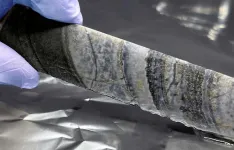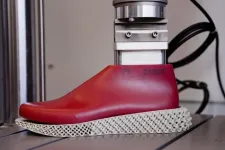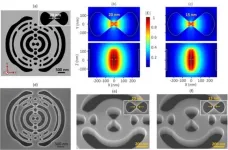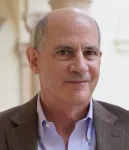(Press-News.org) Microorganisms were the first forms of life on our planet. The clues are written in 3.5 billion-year-old rocks by geochemical and morphological traces, such as chemical compounds or structures that these organisms left behind. However, it is still not clear when and where life originated on Earth and when a diversity of species developed in these early microbial communities. Evidence is scarce and often disputed. Now, researchers led by the University of Göttingen and Linnӕus University in Sweden have uncovered key findings about the earliest forms of life. In rock samples from South Africa, they found evidence dating to around 3.42 billion years ago of an unprecedentedly diverse carbon cycle involving various microorganisms. This research shows that complex microbial communities already existed in the ecosystems during the Palaeoarchaean period. The results were published in the journal Precambrian Research.
The researchers analysed well-preserved particles of carbonaceous matter – the altered remains of living organisms – and the corresponding rock layers from samples of the Barberton greenstone belt, a mountain range in South Africa whose rocks are among the oldest on the Earth's surface. The scientists combined macro and micro analyses to clearly identify original biological traces and distinguish them from later contamination. They identified geochemical "fingerprints" of various microorganisms, including those that must have used sunlight for energy, metabolised sulphate and probably also produced methane. The researchers determined the respective role of the microorganisms in the carbon cycle of the ecosystem at the time by combining geochemical data with findings on the texture of the rocks obtained from thin section analysis with a microscope. "By discovering carbonaceous matter in primary pyrite crystals and analysing carbon and sulphur isotopes in these materials, we were able to distinguish individual microbial metabolic processes," explains the senior author of the study, Dr Henrik Drake from Linnӕus University.
First author Dr Manuel Reinhardt, from Göttingen University’s Geosciences Centre, adds: "We didn't expect to find traces of so many microbial metabolic processes. It was like the proverbial search for a needle in a haystack." The study provides a rare glimpse into the Earth's early ecosystems. "Our findings significantly advance the understanding of ancient microbial ecosystems and open up new avenues for research in the field of palaeobiology."
Original publication: Reinhardt, M. et al. Aspects of the biological carbon cycle in a ca. 3.42-billion-year-old marine ecosystem. Precambrian Research (2024). DOI: 10.1016/j.precamres.2024.107289
Contact:
Dr Manuel Reinhardt
University of Göttingen
Geosciences Centre
Goldschmidtstraße 3, 37077 Göttingen, Germany
Tel: +49 (0)551 39-13756
Email: manuel.reinhardt@uni-goettingen.de
www.uni-goettingen.de/de/646954.html
END
New pieces in the puzzle of first life on Earth
Research team discovers complex microbial communities in ecosystems over 3 billion years ago
2024-01-24
ELSE PRESS RELEASES FROM THIS DATE:
Post pandemic, US cardiovascular death rate continues upward trajectory
2024-01-24
Ann Arbor, January 24, 2024 – New research confirms what public health leaders have been fearing: the significant uptick in the cardiovascular disease (CVD) death rate that began in 2020 has continued. The continuing trend reverses improvements achieved in the decade before the COVID-19 pandemic to reduce mortalities from heart disease and stroke, the leading causes of death in the United States. The findings are reported in the American Journal of Preventive Medicine, published by Elsevier.
Investigators from the US Centers for Disease Control and Prevention ...
New model predicts how shoe properties affect a runner’s performance
2024-01-24
A good shoe can make a huge difference for runners, from career marathoners to couch-to-5K first-timers. But every runner is unique, and a shoe that works for one might trip up another. Outside of trying on a rack of different designs, there’s no quick and easy way to know which shoe best suits a person’s particular running style.
MIT engineers are hoping to change that with a new model that predicts how certain shoe properties will affect a runner’s performance.
The simple model incorporates ...
Sub-wavelength confinement of light demonstrated in indium phosphide nanocavity
2024-01-24
WASHINGTON — As we transition to a new era in computing, there is a need for new devices that integrate electronic and photonic functionalities at the nanoscale while enhancing the interaction between photons and electrons. In an important step toward fulfilling this need, researchers have developed a new III-V semiconductor nanocavity that confines light at levels below the so-called diffraction limit.
“Nanocavities with ultrasmall mode volumes hold great promise for improving a wide range of photonic ...
Laura M. Barzilai, JD, LLM, elected Chair of Board of Directors of the American Federation for Aging Research (AFAR)
2024-01-24
NEW YORK— The American Federation for Aging Research (AFAR), a national, nonprofit whose mission is to advance and support healthy aging through biomedical research, is pleased to announce the election of Laura M. Barzilai, JD, LLM, as Chair of the Board of Directors.
Stephanie Lederman, EdM, AFAR Executive Director, shares: "The Board of Directors of AFAR unanimously elected Laura Barzilai as Chair in December 2023. For nearly a decade, her contributions as a board member, committee chair, ...
Talking tomatoes: How their communication is influenced by enemies and friends
2024-01-24
Plants produce a range of chemicals known as volatile organic compounds that influence their interactions with the world around them. In a new study, researchers at the University of Illinois Urbana-Champaign investigated how the type and amount of these VOCs change based on different features of tomato plants.
The smell of cut grass is one of the defining fragrances of summer. Smells like that are one of the ways plants signal their injury. Because they cannot run away from danger, plants have evolved to communicate with each other using chemical signals. They use VOCs for a ...
Thomas A. Rando, MD, PhD, elected President of the Board of Directors of the American Federation for Aging Research (AFAR)
2024-01-24
The American Federation for Aging Research (AFAR), a national, nonprofit whose mission is to advance and support healthy aging through biomedical research, is pleased to announce the election of Thomas A. Rando, MD, PhD, as President of the Board of Directors in December 2023.
Dr. Rando is currently the Director of the Eli and Edythe Broad Center of Regenerative Medicine and Stem Cell Biology at UCLA, where he is a professor of Neurology and Molecular, Cell, and Developmental Biology. Previously, he ...
Fast-charging lithium battery seeks to eliminate ‘range anxiety’
2024-01-24
ITHACA, N.Y. – Cornell University engineers have created a new lithium battery that can charge in under five minutes – faster than any such battery on the market – while maintaining stable performance over extended cycles of charging and discharging.
The breakthrough could alleviate “range anxiety” among drivers who worry electric vehicles cannot travel long distances without a time-consuming recharge.
“Range anxiety is a greater barrier to electrification in transportation than any of the other barriers, like cost and capability of batteries, and we have identified a pathway to eliminate it using rational electrode designs,” said Lynden ...
Chemistry professor R. Graham Cooks expands research of water droplet interfaces that offer the secret ingredient for building life
2024-01-24
R. Graham Cooks, the Henry B. Hass Distinguished Professor of Chemistry, and his postdoctoral researcher Lingqi Qiu have experimental evidence that the key step in protein formation can occur in droplets of pure water, and have recently published these findings in the Proceedings of the National Academy of Sciences (PNAS).
In this key step, amino acids are dehydrated (they lose water) even though they are in a water solution, a paradox that is resolved by the fact that these droplet surfaces are unusually dry and highly ...
Brain mechanism teaches mice to avoid bullies
2024-01-24
Like humans, mice live in complex social groups, fight over territory and mates, and learn when it is safer to avoid certain opponents. After losing even a brief fight, the defeated animals will flee from the mice that hurt them for weeks afterward, a new study shows.
Led by researchers at NYU Grossman School of Medicine, the study reveals that such “retreating behavior” is influenced by a distinct area on the underside of the hypothalamus, a part of the brain that controls hunger, sleep, and levels of many hormones. The team had previously found that this special region, called the anterior ventrolateral part of the ventromedial hypothalamus (aVMHvl), ...
New tool reveals gene behavior in bacteria
2024-01-24
Bacterial infections cause millions of deaths each year, with the global threat made worse by the increasing resistance of the microbes to antibiotic treatments. This is due in part to the ability of bacteria to switch genes on and off as they sense environmental changes, including the presence of drugs. Such switching is accomplished through transcription, which converts the DNA in genes into its chemical cousin in mRNA, which guides the building of proteins that make up the microbe’s structure.
For this ...
LAST 30 PRESS RELEASES:
Strategic river sensors could have forewarned of Texas Camp flood disaster
Drone sampling of whale breath reveals first evidence of potentially deadly virus in Arctic
Roman soldiers defending Hadrian’s Wall infected by parasites, study finds
Pinochet’s prisoners were tormented with music but still found solace in it, a new book reveals
Fertility remains high in rural Tanzania despite access to family planning
AI-assisted device can improve autism care access
Kinetic careers
Uncovering how parasitic plants avoid attacking themselves to improve crop resistance
Nanoparticle vaccine strategy could protect against Ebola and other deadly filoviruses
Study finds brain care score can predict risk of stroke across racial groups
Key lung immune cells can intensify allergic reactions
Do hormones explain why women experience more gut pain?
New materials conduct ions in solids as easily as in liquids
Breakthrough of the Year: Renewable energy begins to eclipse fossil fuel-based sources
LLM use is reshaping scientific enterprise by increasing output, reducing quality and more
Introducing LightGen, a chip for ultra-fast, ultra-efficient generative AI
Astronomers see fireworks from violent collisions around nearby star
ACC/AHA issue new guideline on managing congenital heart disease in adults
Cosmic crash caught on camera
Is talented youth nurtured the wrong way? New study shows: top performers develop differently than assumed
Ants: An untapped resource in the development of antibiotics?
Archaeologists use AI to create prehistoric video game
Mitochondria migrate toward the cell membrane in response to high glucose levels
Tiny viral switch offers hope against drug-resistant bacteria
Most parents aware of early peanut introduction guidelines, but confused about details
HPV vaccine can protect against severe lesions of the vulva and vagina
Virtual care provision and emergency department use among children and youth
Quadrivalent HPV vaccine and high-grade vulvovaginal lesions
Insights into dry eyes gained from stem cell-derived tear glands
Researchers identify 166 human pluripotent stem cell lines available for use in clinical applications
[Press-News.org] New pieces in the puzzle of first life on EarthResearch team discovers complex microbial communities in ecosystems over 3 billion years ago






